YAMAHA KODIAK 700 2019 Manual Online
Manufacturer: YAMAHA, Model Year: 2019, Model line: KODIAK 700, Model: YAMAHA KODIAK 700 2019Pages: 180, PDF Size: 6.41 MB
Page 81 of 180
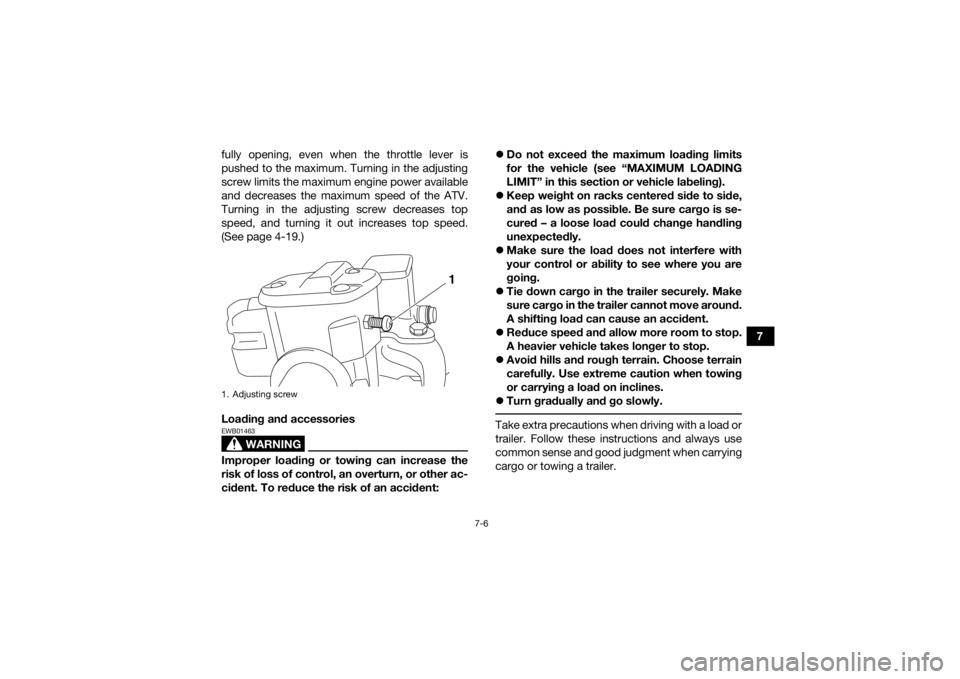
7-6
7
fully opening, even when the throttle lever is
pushed to the maximum. Turning in the adjusting
screw limits the maximum engine power available
and decreases the maximum speed of the ATV.
Turning in the adjusting screw decreases top
speed, and turning it out increases top speed.
(See page 4-19.)
Loading and accessories
WARNING
EWB01463Improper loading or towing can increase the
risk of loss of control, an overturn, or other ac-
cident. To reduce the risk of an accident:
Do not exceed the maximum loading limits
for the vehicle (see “MAXIMUM LOADING
LIMIT” in this section or vehicle labeling).
Keep weight on racks centered side to side,
and as low as possible. Be sure cargo is se-
cured – a loose load could change handling
unexpectedly.
Make sure the load does not interfere with
your control or ability to see where you are
going.
Tie down cargo in the trailer securely. Make
sure cargo in the trailer cannot move around.
A shifting load can cause an accident.
Reduce speed and allow more room to stop.
A heavier vehicle takes longer to stop.
Avoid hills and rough terrain. Choose terrain
carefully. Use extreme caution when towing
or carrying a load on inclines.
Turn gradually and go slowly.
Take extra precautions when driving with a load or
trailer. Follow these instructions and always use
common sense and good judgment when carrying
cargo or towing a trailer.
1. Adjusting screw
1
UB5K60E0.book Page 6 Monday, May 28, 2018 11:35 AM
Page 82 of 180
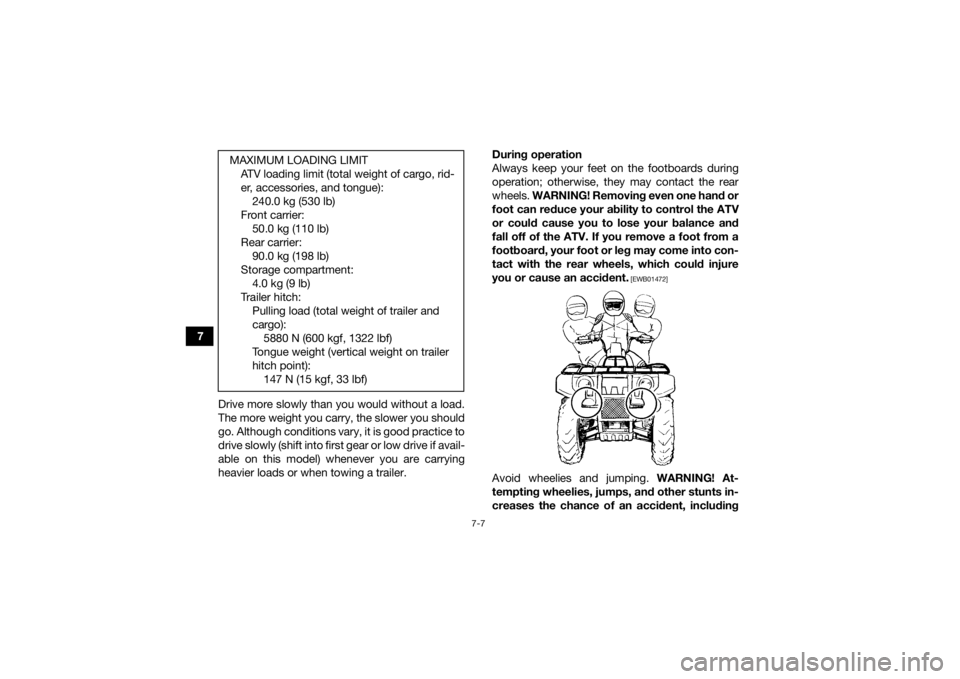
7-7
7Drive more slowly than you would without a load.
The more weight you carry, the slower you should
go. Although conditions vary, it is good practice to
drive slowly (shift into first gear or low drive if avail-
able on this model) whenever you are carrying
heavier loads or when towing a trailer. During operation
Always keep your feet on the footboards during
operation; otherwise, they may contact the rear
wheels.
WARNING! Removing even one hand or
foot can reduce your ability to control the ATV
or could cause you to lose your balance and
fall off of the ATV. If you remove a foot from a
footboard, your foot or leg may come into con-
tact with the rear wheels, which could injure
you or cause an accident.
[EWB01472]
Avoid wheelies and jumping. WARNING! At-
tempting wheelies, jumps, and other stunts in-
creases the chance of an accident, including
MAXIMUM LOADING LIMIT
ATV loading limit (total weight of cargo, rid-
er, accessories, and tongue):240.0 kg (530 lb)
Front carrier: 50.0 kg (110 lb)
Rear carrier: 90.0 kg (198 lb)
Storage compartment: 4.0 kg (9 lb)
Trailer hitch: Pulling load (total weight of trailer and
cargo):5880 N (600 kgf, 1322 lbf)
Tongue weight (vertical weight on trailer
hitch point): 147 N (15 kgf, 33 lbf)
UB5K60E0.book Page 7 Monday, May 28, 2018 11:35 AM
Page 83 of 180
![YAMAHA KODIAK 700 2019 Manual Online 7-8
7
an overturn. Never attempt stunts, such as
wheelies or jumps. Don’t try to show off.
[EWB01482]Modifications and accessories
Never modify this ATV through improper installa-
tion or use of acc YAMAHA KODIAK 700 2019 Manual Online 7-8
7
an overturn. Never attempt stunts, such as
wheelies or jumps. Don’t try to show off.
[EWB01482]Modifications and accessories
Never modify this ATV through improper installa-
tion or use of acc](/img/51/50560/w960_50560-82.png)
7-8
7
an overturn. Never attempt stunts, such as
wheelies or jumps. Don’t try to show off.
[EWB01482]Modifications and accessories
Never modify this ATV through improper installa-
tion or use of accessories or other modification. All
parts and accessories added to this ATV should
be genuine Yamaha or equivalent components
designed for use on this ATV and should be in-
stalled and used according to instructions. If you
have questions, consult an authorized ATV dealer.
WARNING! Operating this ATV with improper modifications may cause changes in handling
which in some situations could lead to an acci-
dent.
[EWB01492]
Exhaust system
WARNING
EWB01502 Dry grass or brush or other combustible ma-
terial accumulated around the engine area
could catch fire. Do not operate, idle, or park
the ATV in dry grass or other dry ground cov-
er. Keep the engine area free of dry grass,
brush, or other combustible material.
Someone touching the exhaust system dur-
ing or after operation could be burned. Do
not touch the hot exhaust system. Do not
park the ATV in a place where others might
be likely to touch it. The muffler and other engine parts become ex-
tremely hot during operation and remain hot after
the engine has stopped. To reduce the risk of fire
during operation or after leaving the ATV, do not
let brush, grass and other materials collect under
the vehicle, near the muffler or exhaust pipe, or
next to other hot parts. Check under the vehicle
after operating in areas where combustible mate-
rials may have collected. Do not idle or park the
vehicle in long dry grass or other dry ground cov-
er.
UB5K60E0.book Page 8 Monday, May 28, 2018 11:35 AM
Page 84 of 180
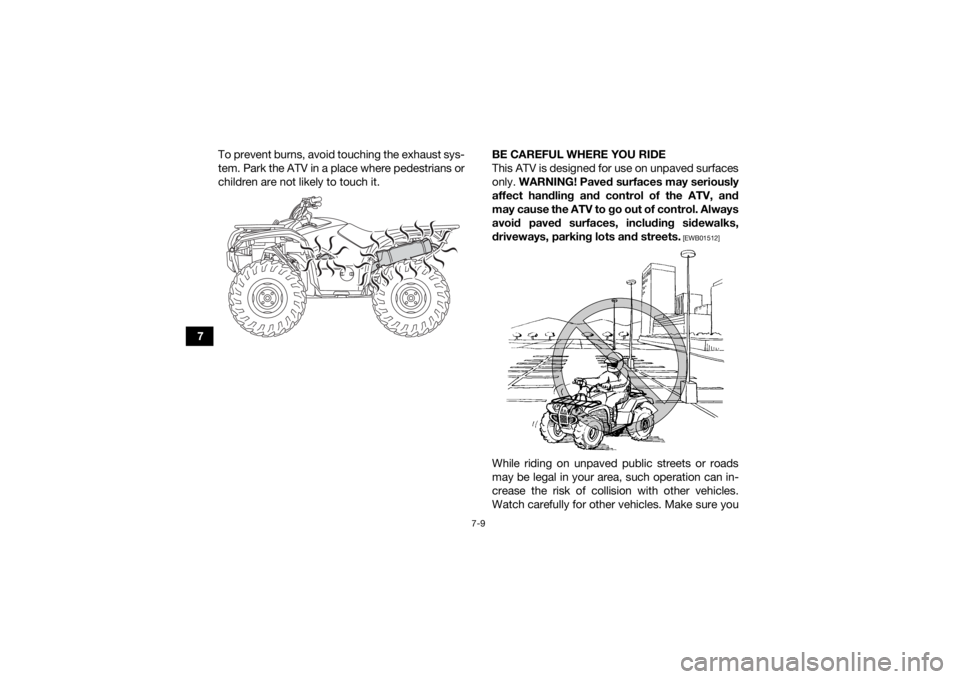
7-9
7To prevent burns, avoid touching the exhaust sys-
tem. Park the ATV in a place where pedestrians or
children are not likely to touch it.
BE CAREFUL WHERE YOU RIDE
This ATV is designed for use on unpaved surfaces
only.
WARNING! Paved surfaces may seriously
affect handling and control of the ATV, and
may cause the ATV to go out of control. Always
avoid paved surfaces, including sidewalks,
driveways, parking lots and streets.
[EWB01512]
While riding on unpaved public streets or roads
may be legal in your area, such operation can in-
crease the risk of collision with other vehicles.
Watch carefully for other vehicles. Make sure you
UB5K60E0.book Page 9 Monday, May 28, 2018 11:35 AM
Page 85 of 180
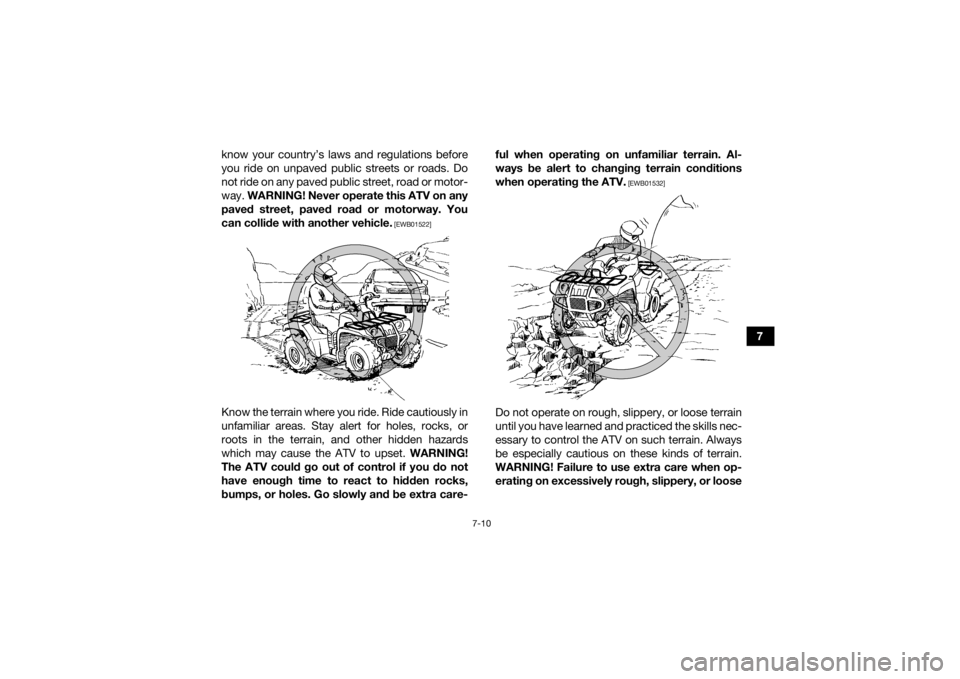
7-10
7
know your country’s laws and regulations before
you ride on unpaved public streets or roads. Do
not ride on any paved public street, road or motor-
way.
WARNING! Never operate this ATV on any
paved street, paved road or motorway. You
can collide with another vehicle.
[EWB01522]
Know the terrain where you ride. Ride cautiously in
unfamiliar areas. Stay alert for holes, rocks, or
roots in the terrain, and other hidden hazards
which may cause the ATV to upset. WARNING!
The ATV could go out of control if you do not
have enough time to react to hidden rocks,
bumps, or holes. Go slowly and be extra care- ful when operating on unfamiliar terrain. Al-
ways be alert to changing terrain conditions
when operating the ATV.
[EWB01532]
Do not operate on rough, slippery, or loose terrain
until you have learned and practiced the skills nec-
essary to control the ATV on such terrain. Always
be especially cautious on these kinds of terrain.
WARNING! Failure to use extra care when op- erating on excessively rough, slippery, or loose
UB5K60E0.book Page 10 Monday, May 28, 2018 11:35 AM
Page 86 of 180
![YAMAHA KODIAK 700 2019 Manual Online 7-11
7terrain could cause loss of traction or ATV con-
trol, which could result in an accident, includ-
ing an overturn.
[EWB01542]
When riding in an area where you might not easily
be seen, such as YAMAHA KODIAK 700 2019 Manual Online 7-11
7terrain could cause loss of traction or ATV con-
trol, which could result in an accident, includ-
ing an overturn.
[EWB01542]
When riding in an area where you might not easily
be seen, such as](/img/51/50560/w960_50560-85.png)
7-11
7terrain could cause loss of traction or ATV con-
trol, which could result in an accident, includ-
ing an overturn.
[EWB01542]
When riding in an area where you might not easily
be seen, such as desert terrain, mount a caution
flag on the ATV. DO NOT use the flag pole bracket
as a trailer hitch.
WARNING! You could collide
with another vehicle if operating in areas
where you cannot easily be seen. Mount a cau-
tion flag on the ATV to make you more visible.
Watch carefully for other vehicles.
[EWB01552]
Do not ride in areas posted “no trespassing”.
Do not ride on private property without getting
permission.
UB5K60E0.book Page 11 Monday, May 28, 2018 11:35 AM
Page 87 of 180
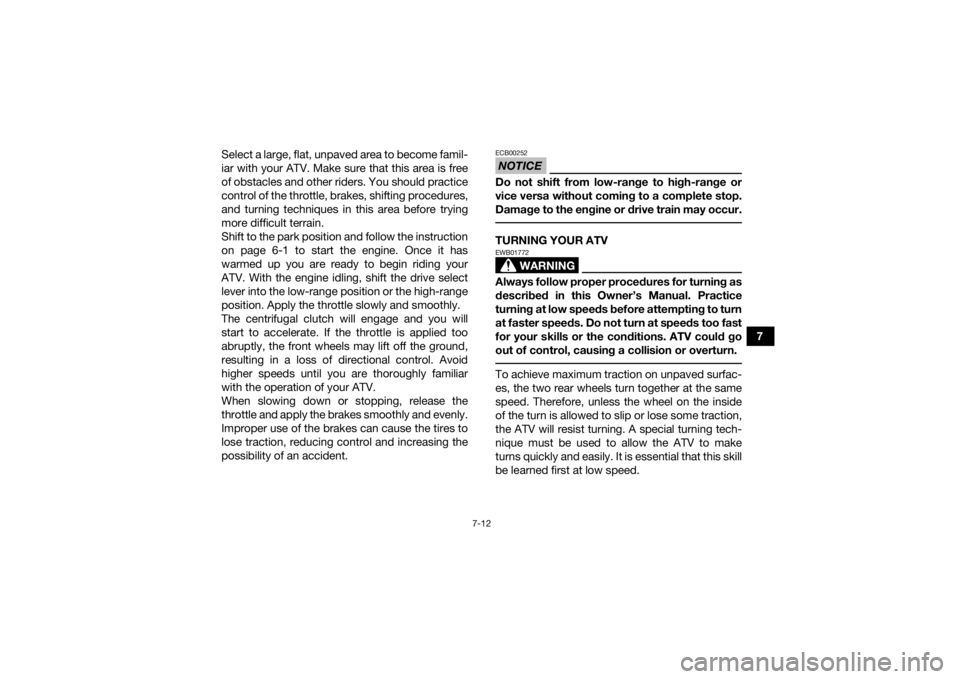
7-12
7
Select a large, flat, unpaved area to become famil-
iar with your ATV. Make sure that this area is free
of obstacles and other riders. You should practice
control of the throttle, brakes, shifting procedures,
and turning techniques in this area before trying
more difficult terrain.
Shift to the park position and follow the instruction
on page 6-1 to start the engine. Once it has
warmed up you are ready to begin riding your
ATV. With the engine idling, shift the drive select
lever into the low-range position or the high-range
position. Apply the throttle slowly and smoothly.
The centrifugal clutch will engage and you will
start to accelerate. If the throttle is applied too
abruptly, the front wheels may lift off the ground,
resulting in a loss of directional control. Avoid
higher speeds until you are thoroughly familiar
with the operation of your ATV.
When slowing down or stopping, release the
throttle and apply the brakes smoothly and evenly.
Improper use of the brakes can cause the tires to
lose traction, reducing control and increasing the
possibility of an accident.
NOTICEECB00252Do not shift from low-range to high-range or
vice versa without coming to a complete stop.
Damage to the engine or drive train may occur. TURNING YOUR ATV
WARNING
EWB01772Always follow proper procedures for turning as
described in this Owner’s Manual. Practice
turning at low speeds before attempting to turn
at faster speeds. Do not turn at speeds too fast
for your skills or the conditions. ATV could go
out of control, causing a collision or overturn. To achieve maximum traction on unpaved surfac-
es, the two rear wheels turn together at the same
speed. Therefore, unless the wheel on the inside
of the turn is allowed to slip or lose some traction,
the ATV will resist turning. A special turning tech-
nique must be used to allow the ATV to make
turns quickly and easily. It is essential that this skill
be learned first at low speed.
UB5K60E0.book Page 12 Monday, May 28, 2018 11:35 AM
Page 88 of 180
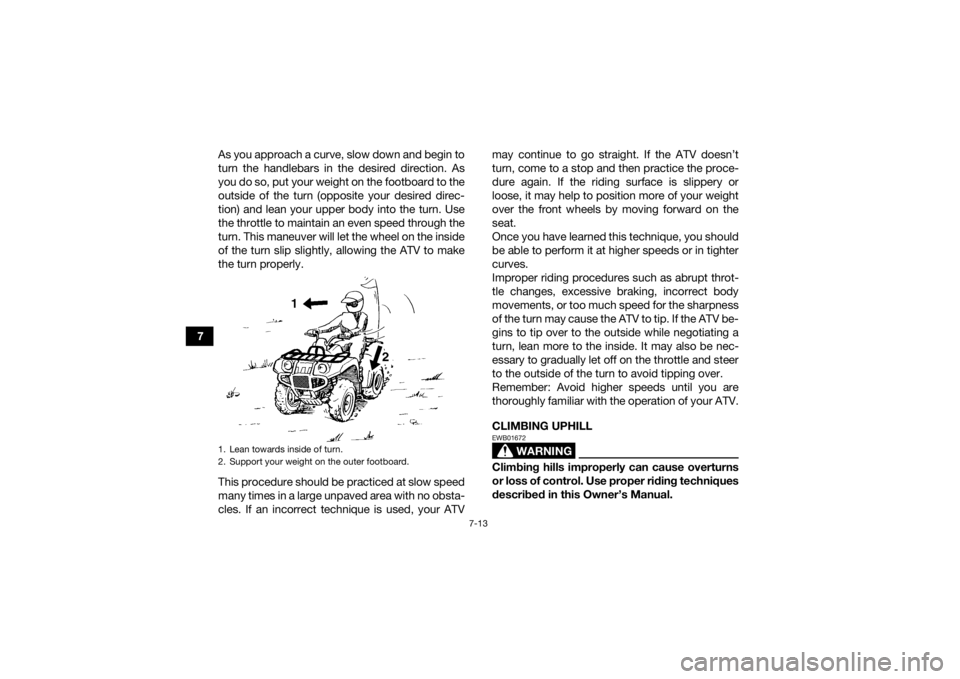
7-13
7As you approach a curve, slow down and begin to
turn the handlebars in the desired direction. As
you do so, put your weight on the footboard to the
outside of the turn (opposite your desired direc-
tion) and lean your upper body into the turn. Use
the throttle to maintain an even speed through the
turn. This maneuver will let the wheel on the inside
of the turn slip slightly, allowing the ATV to make
the turn properly.
This procedure should be practiced at slow speed
many times in a large unpaved area with no obsta-
cles. If an incorrect technique is used, your ATV may continue to go straight. If the ATV doesn’t
turn, come to a stop and then practice the proce-
dure again. If the riding surface is slippery or
loose, it may help to position more of your weight
over the front wheels by moving forward on the
seat.
Once you have learned this technique, you should
be able to perform it at higher speeds or in tighter
curves.
Improper riding procedures such as abrupt throt-
tle changes, excessive braking, incorrect body
movements, or too much speed for the sharpness
of the turn may cause the ATV to tip. If the ATV be-
gins to tip over to the outside while negotiating a
turn, lean more to the inside. It may also be nec-
essary to gradually let off on the throttle and steer
to the outside of the turn to avoid tipping over.
Remember: Avoid higher speeds until you are
thoroughly familiar with the operation of your ATV.
CLIMBING UPHILL
WARNING
EWB01672Climbing hills improperly can cause overturns
or loss of control. Use proper riding techniques
described in this Owner’s Manual.
1. Lean towards inside of turn.
2. Support your weight on the outer footboard.UB5K60E0.book Page 13 Monday, May 28, 2018 11:35 AM
Page 89 of 180
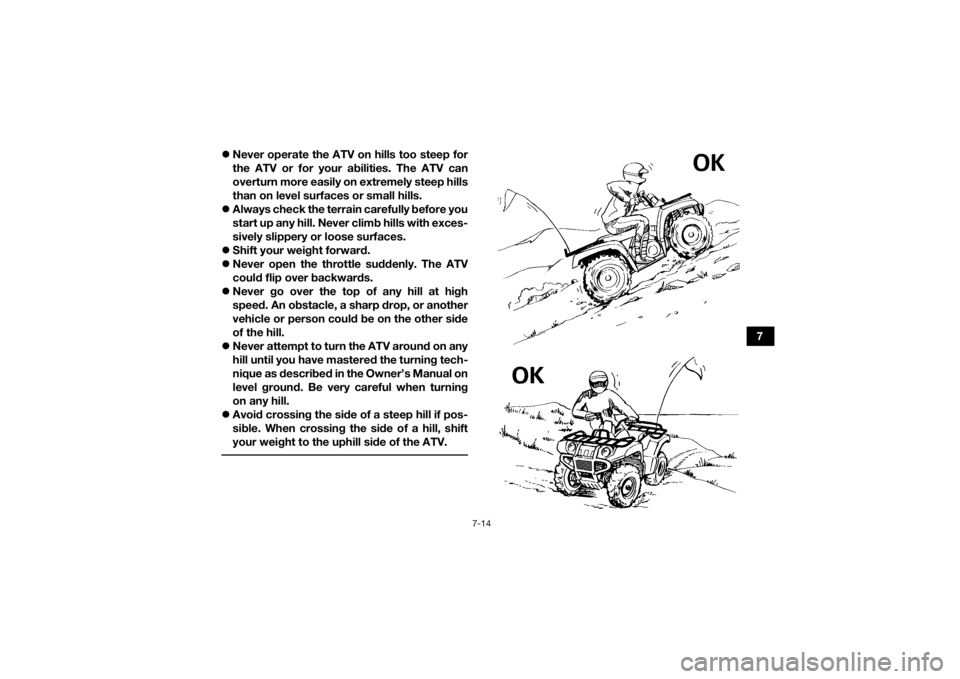
7-14
7
Never operate the ATV on hills too steep for
the ATV or for your abilities. The ATV can
overturn more easily on extremely steep hills
than on level surfaces or small hills.
Always check the terrain carefully before you
start up any hill. Never climb hills with exces-
sively slippery or loose surfaces.
Shift your weight forward.
Never open the throttle suddenly. The ATV
could flip over backwards.
Never go over the top of any hill at high
speed. An obstacle, a sharp drop, or another
vehicle or person could be on the other side
of the hill.
Never attempt to turn the ATV around on any
hill until you have mastered the turning tech-
nique as described in the Owner’s Manual on
level ground. Be very careful when turning
on any hill.
Avoid crossing the side of a steep hill if pos-
sible. When crossing the side of a hill, shift
your weight to the uphill side of the ATV.
UB5K60E0.book Page 14 Monday, May 28, 2018 11:35 AM
Page 90 of 180

7-15
7Do not attempt to climb hills until you have mas-
tered basic maneuvers on flat ground. Always
check the terrain carefully before attempting any
hill. In all cases avoid inclines with slippery or
loose surfaces, or obstacles that might cause you
to lose control.
To climb a hill, you need traction, momentum, and
steady throttle. For more traction and control for
climbing steeper and/or rougher slopes, select
“4WD” or 4WD-LOCK (“DIFF. LOCK”)
(YFM70KPXK / YFM70KPAK / YFM70KPHK /
YFM70KPSK / YFM70KPLK). Travel fast enough
to maintain momentum, but not so fast that you
cannot react to changes in the terrain as you
climb.
It is important when climbing a hill to make sure
that your weight is transferred forward on the ATV.
This can be accomplished by leaning forward and,
on steeper inclines, standing on the footboards
and leaning forward over the handlebars. When-
ever possible, ride straight up hills.
Slow down when you reach the crest of the hill if
you cannot see clearly what is on the other side –
there could be another person, an obstacle, or a sharp drop-off. Use common sense and remem-
ber that some hills are too steep for you to climb
or descend.
If you are climbing a hill and you find that you have
not properly judged your ability to make it to the
top, you should turn the ATV around while you still
have forward motion (provided you have the room
to do so) and go down the hill.
If your ATV has stalled or stopped and you believe
you can continue up the hill, restart carefully to
make sure you do not lift the front wheels which
could cause you to lose control. If you are unable
to continue up the hill, dismount the ATV on the
uphill side. Physically turn the ATV around and
then descend the hill.
If you start to roll backwards, DO NOT apply either
brake abruptly. If you are in “2WD”, apply only the
front brake. When fully stopped, apply the rear
brake as well, and then shift to the park position. If
you are in “4WD”, because all wheels are inter-
connected by the drive train, applying either brake
will brake all wheels, therefore, avoid sudden ap-
plication of either the front or rear brake as the
wheels on the uphill side could come off the
ground. The ATV could easily tip over backwards.
Apply both the front and rear brakes gradually.
UB5K60E0.book Page 15 Monday, May 28, 2018 11:35 AM